Positive Health Online
Your Country

Flower Power
listed in herbal medicine, originally published in issue 270 - May 2021
Flowers…are a proud assertion that a ray of beauty outvalues all the utilities of the world.
Ralph Waldo Emerson (1803-1882)
We are in the middle of the flower season, as I am sure you will have noticed. In the old herbal traditions, as in many other healing arts, flowers are linked to the element of air and the sanguine temperament – enthusiastic, extroverted, sociable, outgoing and charismatic.
Air is space, breath is life. The Greek word for air, pneuma, also means divine knowledge or reason, so air represents thought as well as mental or psychological phenomena.
As the light grows stronger, Spring turns to Summer, and flowers turn to fruit and seed. From the Spring equinox to the Summer solstice, flowers reign as the days grow lighter, warmer and drier.
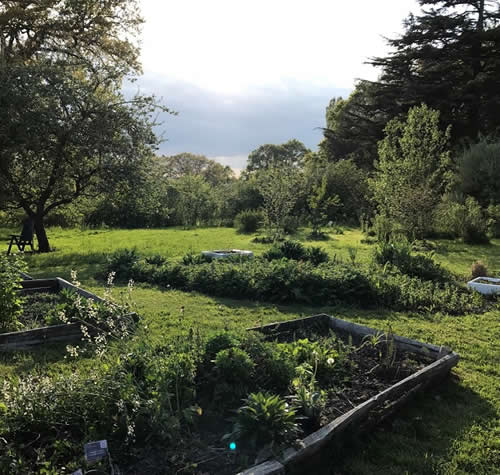
The Apothecary Garden in Spring
Here at Heartwood Botanic, in the Biodynamic Botanic Garden at Emerson College, we observe how nature changes as the seasons turn, and we celebrate and respect each time of day or year for what it brings.
It is midmorning as I write, and the mist is clearing over the apothecary garden, becoming whiter and and more transparent as the landscape emerges under it. The sun will break through soon, soft spring sunshine, so sharp at this time of year.
This quarter is all about light and air – greens appearing pale and almost fluorescent, turning darker and gentler as the days go by and the sun’s yang energy continues to intensify, stimulating the drying powers of heat and air.
Plants make the most of this season. The culmination of the growth of flowering plants is to produce flowers that can be pollinated and become seeds, securing the next generation and, as soon as flower buds start appearing, the energy moves away from the leaves that appeared earlier in the year. So, if you want to harvest leaves, do it before your plants start to flower.
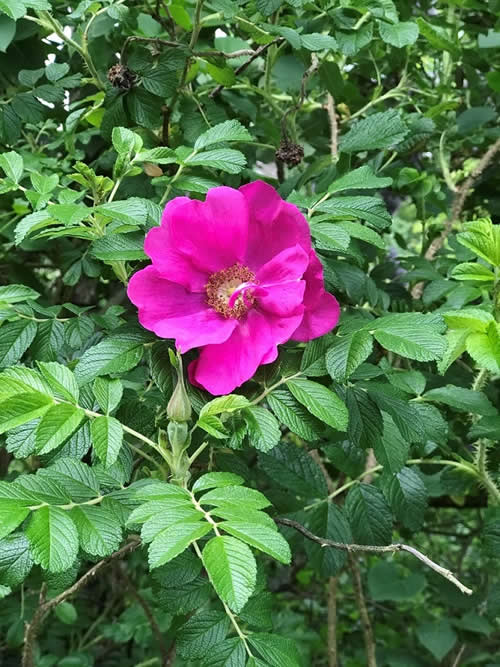
Hip Rose
Flowers to Harvest in May
- Calendula flowers
- Chickweed herb and flowers
- Daisy flowers
- Dandelion leaves and flowers
- Elderflowers
- Hawthorn flowering tops
- Lemon balm tops
- Pansy
- Red clover flowers
- Rose petals
Flowers are best harvested in the late morning on a sunny day when they are fully open. Try not to touch the petals and treat these delicate beauties with care. Once picked, spread them out on wire trays (or similar) and dry them in the shade.
Scientists, artists and healers have always been fascinated by flowers whose sexual organs attract pollinators in ingenious and beautiful ways to secure the survival of the plant and all its descendants.
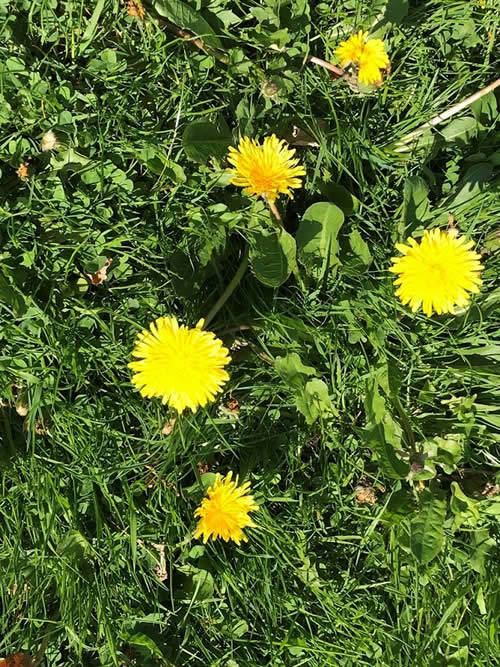
Dandelion
Apart from their medicinal properties, flowers open our eyes to the wonders of life, to the gift of love and longing. Each spring they enchant us with their promise of warmth and new life. And as the sun grows stronger over the horizon, more flowers open like a stream of scented colour covering the earth and bringing new life.
Some have taken thousands or millions of years - others only centuries - to evolve their complex, precise and perfect patterns of harmony and grace. People try to control and sometimes eradicate flowers, perhaps without realising that they are the foundation for life as we know it, and for the beauty and abundance that surrounds us. The human race has used flowers for thousands of years to heal, nourish and uplift mind, body and spirit.
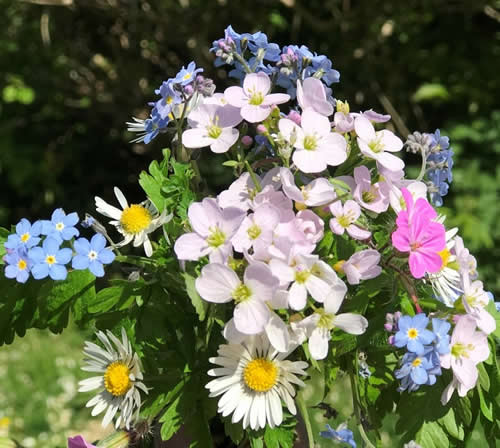
Wildflower Bouquet from the Meadow Forget-Me-Not, Daisy, Cuckoo Flower, Herb Robert
In the apothecary garden, we have planted a wildflower meadow and are now waiting for it to flower and show us how meadows used to look all over the country before modern agricultural practices rationalised things and sprayed them all away. Luckily, that tide is turning. We sow mainly in February and March, propagate and plant out in April and May, and harvest leaves before the flowers start appearing later in the spring. Seeds and fruits generally start to ripen for harvest in July, culminating around Lammas in August and continuing well into September. The lightest quarter of the year starts with Beltane at the beginning of May, and it continues to Lammas Day [also known as Loaf Mass Day, is a Christian holiday celebrated in some English-speaking countries in the Northern Hemisphere on 1 August.].
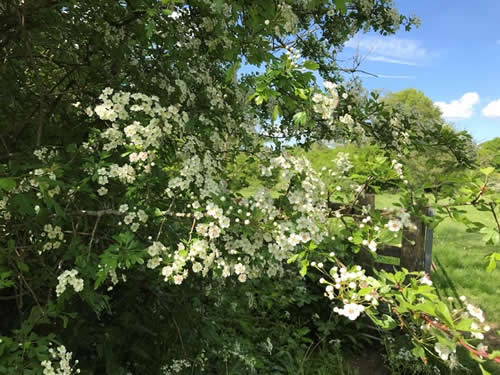
Hawthorn in Flower
Having reached its strongest intensity at the summer solstice, the height of Yang, the light starts to fade again. Although the darkness and the inward looking, anabolic, restorative power of Yin is born at the height of the outward going, catabolic power of Yang, the hot sun power still grows in intensity. The days grow shorter, but the heat intensifies until the beginning of autumn. You can feel it in the evening air after Lammas, and plants react by dropping their seeds, to make the most of the increasing moisture and the return of the energy to the earth with the increasing hours of darkness.
After the season of fruits and seeds comes the autumn equinox, the second balance point of the year, where we enter the season of earth and roots. Leaves fall, sap retreats.
The first of November is Samhain, the dying of the light, the death of Yang, and the beginning of the dark quarter, which takes us to the winter solstice and maximum Yin, the most anabolic, inward looking part of the year. A time to gather resources to withstand the winter and the lean season.
In the natural farming year, the energetic tide turns at the winter solstice (the darkest point of the year, the height of Yin), and Yang and the light begin to return. But although the days grow longer, and the light stronger, winter is just beginning and will not reach its height until Imbolc marks the end of the dark quarter and the beginning of Spring. Imbolc, at the beginning of February marks an important point in the traditional farming year as it is halfway to the next Lammas harvest in August.
And so the years keep turning…
In the garden, we follow this cycle closely and consciously, partly because we have to, and mostly because we want to. The same cycle is also repeated in each day, where the winter and summer solstices represent midnight and midday.
Each season is equally important for the whole, but there is something about the season of flowers that make us fall in love with life and each other all over again. The fine fragrance and the delicate beauty flowers bring reminds us of the finer parts of life.
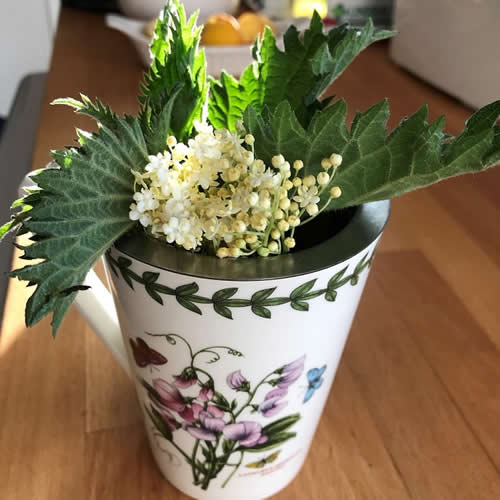
Elderflowers
- Botanical name: Sambucus nigra (L)
- Other names: Black elder, common elder, pipe tree, hyldor, ellhorn
- Family name: Viburnaceae
- Parts used: Flowers (berries in the autumn)
The elder is native to most of Europe and is closely related to the American elder which has similar active constituents and can be used in same way as European elder. It is easily recognizable at this time of year with its flat heads of tiny fragrant creamy-white flowers.
The elder has a long history of use as food, medicine and in the household. The name “elder” comes from the Anglo-Saxon word for fire (Æld). This may relate to the use of the young stems as bellows to get a fire going. They contain a soft pith which is easily removed, leaving a hollow tube to blow in. The hollow stems were also used for pipes and whistles, hence the name “pipe tree”. Native Americans call it “the tree of music” for the same reason.
Elder trees are also good nesting habitats for small birds. Elderflowers and berries provide nectar and food for many different insects and small mammals. Moth caterpillars feed on the leaves, which give off a strong smell, are poisonous to flees and lice, and they are disliked by flies and mosquitos. Bruised leaves can be used as an insect repellent. A natural insecticide can be made by boiling 4 handfuls of leaves in a litre of water for 15 minutes (strain, cool, and use in a diffuser).
- Elderflowers contain choline, bioflavonoids (including rutin, quercetin and kaempferol), mucilage, sterols, pectin, tannin and volatile oils. They are anti-catarrhal, anti-inflammatory, expectorant, circulatory and immune stimulant.
- The combined effect of the active constituents is to enhance natural resistance to disease, and to promote perspiration – removing heat from the body and cooling fevers – so they are excellent for viral infections, especially respiratory tract problems such as colds and flu, hay fever and other allergic symptoms and catarrh. The effect of the flowers can be enhanced with nettle, mint and yarrow.
- A cold elderflower infusion soaked in clean pads and placed over the eyes can also be used to relieve eye strain and inflammation.
- Fresh elderflowers look beautiful sprinkled on a salad, and they add a lovely aromatic scent and flavour.
- Elderflower tea is easy to make: Take 1-2 fresh elderflower heads, or 1-2 tsp dried, per cup of boiling water. Place the elderflowers in a mug, jug or small teapot. Add the boiling water. Cover and leave to infuse for 5-10 minutes. Strain and drink ½-1 cup every 2 hours for acute conditions.
- For hayfever relief, elderflower combines well with nettle – add 1 top of fresh nettle, or 1 tsp dried, to the above mixture. Strain and drink freely as needed.
- Elderflower vinegar is an excellent addition to salads, and it can also be used for hayfever. Pick 20 fresh elderflower heads. Don’t rinse them but leave them spread out on a tray for a couple of hours after picking to allow any insects to escape. Then cut the blossoms from the flowerhead stalks with scissors and place them in a clean jar. Add 500ml of apple cider vinegar, seal and store in the fridge. Turn the jar upside down every few days for the first couple of weeks, then strain and discard the flowers. Keep the vinegar.
Comments:
-
No Article Comments available